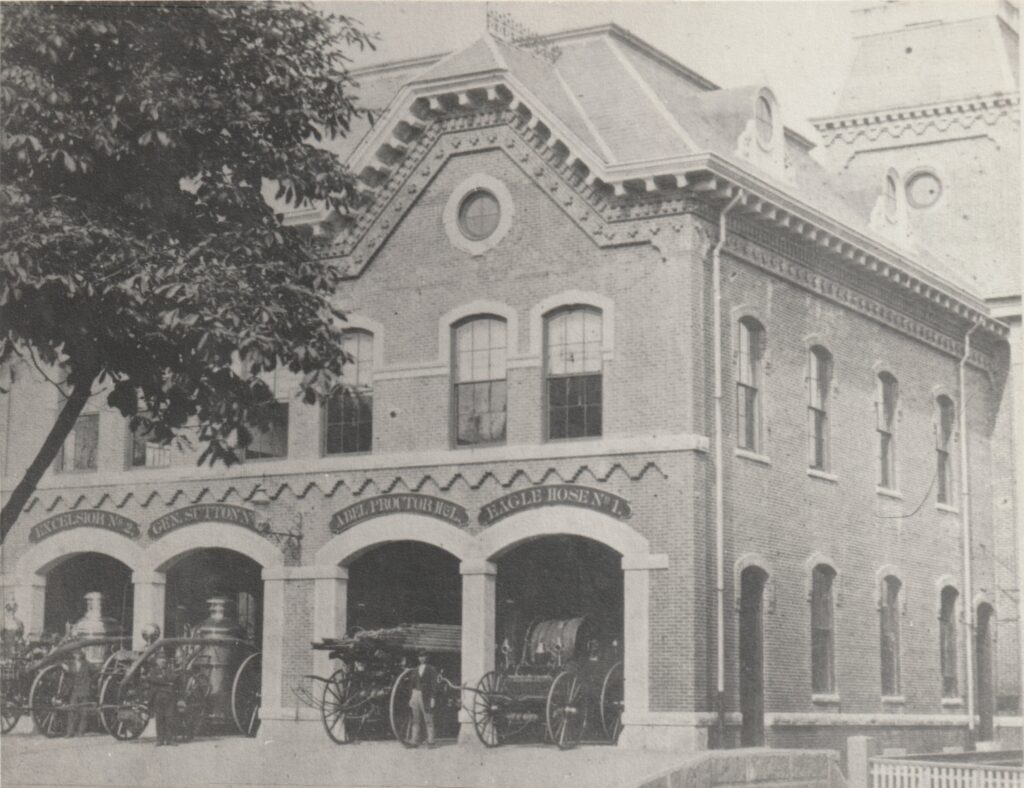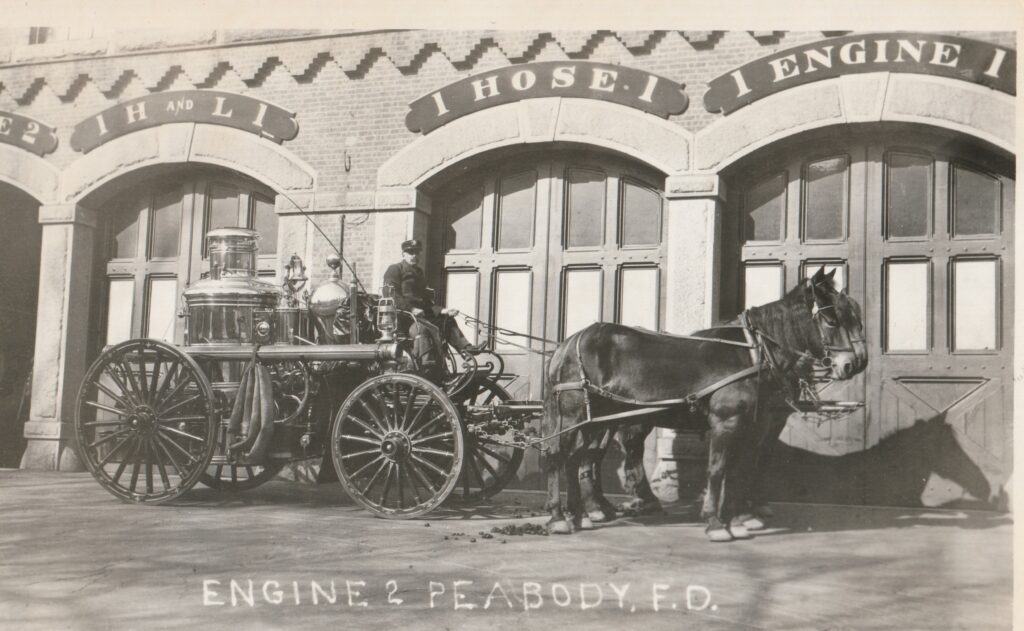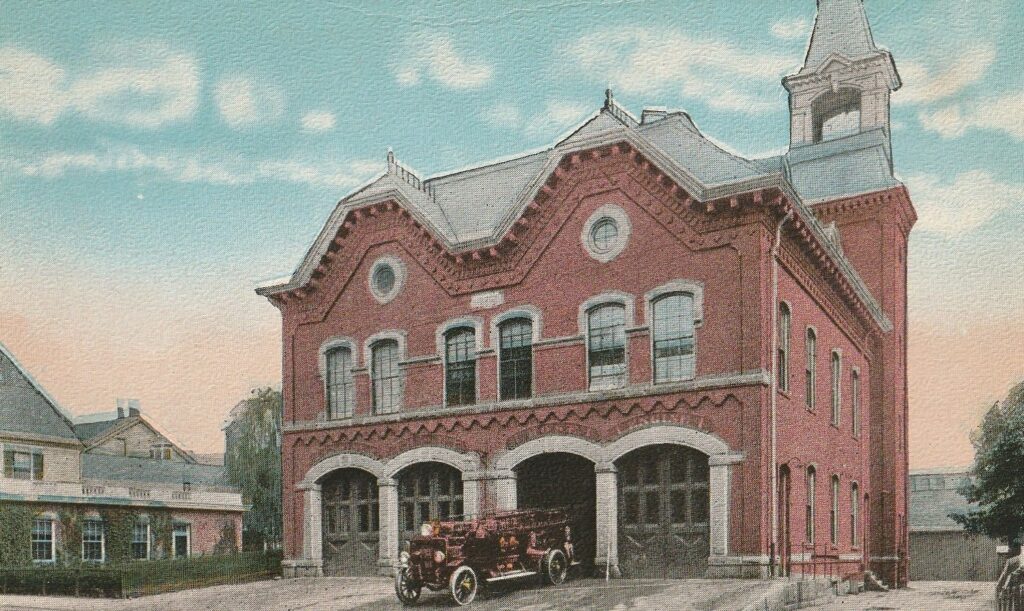Thank you for clicking on this QR code, one of many to explore along Peabody’s Main Street.
This project is a collaboration between the Peabody Historical Society & Museum and the City of Peabody. We hope you enjoy reading about our history!

Central Fire Station, as seen in this image, with Abel Proctor No. 1 Ladder Truck, the General Sutton No. 1 Steamer, Eagle Hose No. 1 and the Excelsior No. 2 Steamer. Circa 1880.
Peabody Central Fire Station at 41 Lowell Street was built in 1873 at a cost of $31,000. The building’s beautiful brickwork and architectural details were restored in 1989. It is one of the oldest continuously operating fire headquarters in the United States. It is listed on the National Register of Historic Places.
Horses played an important role in early firefighting, as they pulled the equipment to the fire. The last of Peabody’s fire horses were named Tom and Jerry. They retired in 1926 by resolution of the city council.

Circa 1884, earlier steamers required two horses to pull it. As the apparatus became heavier, they required three horses. The first motorized fire engine was purchased by the Peabody Fire Department in 1913.

Central Fire House, circa 1916, note the motorized fire truck
Peabody’s brave firefighters have battled major fires over their history. This list was compiled by the Peabody Fire Relief Association in 1984.
1817 Crowninshield woolen mill.
1823 General Foster bark, chocolate, and grist mills.
1843 Conflagration at Peabody Square.
1849 Henry Poor’s tannery, and Crane’s.
1851 Lunt’s shoe factories and Taylor’s bark mill.
1875 E. W. Jacobs’ factory.
1876 Winona woolen mill.
1880 Thomas E. Proctor’s currying shop.
1884 Upton Glue factory – $100,000 loss. Pinder and Winchester tannery $100,000 loss.
1898 Poor and Littlefield Tannery, destroyed during blizzard.
1902 Vaughn’s Machine Company.
1903 Shaw shoe factories destroyed – 250 out of work. Brown’s Glue Works.
1909 Peabody’s largest fire to date. A. B. Clark Leather Company – $350,000 loss.
1915 St. John’s Parochial School – 21 lives taken.
1916 O’Shea Tannery destroyed $200,000 loss; Fireman William Kerwin killed.
1932 Amdur-Limon Tannery destroyed with $500,000 loss. Limon later convicted of arson.
1938 Sawyer block destroyed in $100,000 fire. Body of James Fleming found two weeks after fire.
1951 Ellis Grain and Salwin Leather Company destroyed. Damage estimated between $300 to $500,000.
1952 Center School destroyed.
1953 Historic Paige Pottery destroyed in fire that threatened Wilson Square. Explosion and fire of American Polymer Corporation, one killed and thirty injured. Worst explosion in Peabody’s history. Property loss estimated at between $500,000 to a million, and nearby factories were also damaged.
1954 Wetan Leather Company destroyed, and Red Men’s Hall.
1962 McGivern Furniture store destroyed with $450,000 loss.
1963 City of Peabody Infirmary, Lynnfield St.
1964 100 Lowell St. Jalma Nursing Home, quick action saved all the Patrons’ lives. Gnecco and Grilk factory destroyed in tragic explosion and fire in which five men lost their lives.
1967 Kirstein Leather was one of the first of the large leather companies to burn and threaten the community with large loss not only in tax loss, but also jobs. Others were Verza Tannery, Silva Tannery, Beacon Tannery, B. E. Cox Leather, Corr Leather, Duffies Leather, Modern Leather, Cornet Leather, and Central Leather.
Brings to date the largest tannery fire occurring May 10, 1984, the Henry Leather fire.

